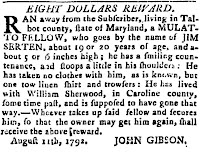Wednesday, March 23, 2011
Using Visuals to Reach ELL Students
Jennifer Gunter
Greensboro Elementary School, Caroline County Public Schools
1. How can I build new activities around primary sources?
I’d like to build new activities around paintings/illustrations/photos etc. While looking at the painting of the Chestertown waterfront during one of our activities, I realized how much one could infer about a subject. Since I do teach a lot of ELL students, using more visuals, without text, is a great tool to meet their needs. A goal would to be to begin every lesson with some sort of illustration/carving/photo etc. Have students examine the primary source and then discuss what they see. They could then evaluate the primary source using one of the forms provided during our sessions. Then the new material could be introduced.
2. Where can I supplement some of my current lesson plans with primary sources?
My slavery lessons can include the runaway ads I discovered. I’ve also found some slave narratives to use, Briton Hammon’s from 1760, for example. We can read about his experience from his point of view. Trying to get my students to put themselves in someone else’s shoes is always a task I try to accomplish. Finally, the illustration of slaves on a slave ship is a powerful tool to show students how people were treated.
Other primary sources I could use are political cartoons. There are cartoons about the Stamp Act and Ben Franklin’s “Join, or Die” cartoon that we can discuss. To find out more about colonial life, there are some Maryland inventories we can look at to see what people in Colonial times possessed. Also, we can look at diary/journal entries to get an idea of what people did daily, especially the diaries of children.
3. How will I use the local source I selected at the workshop to teach my students about the history of their community?
After discussing the newspaper advertisement with students, they will be split into small groups. Each group will have to write from a different point of view. One group will write from Jim’s (the runaway) point of view. Another group will write from John Gibson’s (the man who placed the ad) point of view. The last group will write from the point of view of a person who sees the runaway and has to decide if he/she will turn him in for the reward or turn a blind eye. Each group will need to address the problem/situation as seen through the eyes of their person. It would be great if they could put some local features in their writing, like mentioning the Choptank River or the marsh surrounding an area, or the name of one towns that existed at the time.
